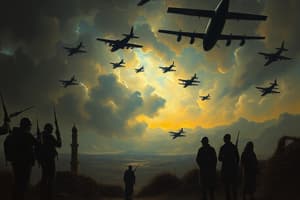Podcast
Questions and Answers
What argument did General Giulio Douhet make regarding the bombing of civilians?
What argument did General Giulio Douhet make regarding the bombing of civilians?
- Bombing civilians was unethical and should be banned.
- Bombing civilians would be ineffective.
- Bombing civilians would boost morale.
- Bombing civilians would quickly demoralize the population and force their leaders to surrender. (correct)
Which nation was the first to bomb civilian areas, leading to worldwide outrage in 1932?
Which nation was the first to bomb civilian areas, leading to worldwide outrage in 1932?
- United States
- Germany
- Italy
- Japan (correct)
What was the main difference between the bombing strategies of the British Royal Air Force (RAF) and the United States Army Air Corps during World War II?
What was the main difference between the bombing strategies of the British Royal Air Force (RAF) and the United States Army Air Corps during World War II?
- The RAF used larger bombs, while the Americans relied on incendiary weapons.
- The RAF conducted nighttime raids, while the Americans preferred daytime raids. (correct)
- The RAF focused on precision bombing, while the Americans used area bombing.
- The RAF avoided bombing civilian areas, while the Americans targeted them directly.
What was the primary objective behind the British adoption of "area bombing" during World War II?
What was the primary objective behind the British adoption of "area bombing" during World War II?
Which city experienced a firestorm as a result of RAF bombing raids in 1943, leading to the deaths of over 40,000 people?
Which city experienced a firestorm as a result of RAF bombing raids in 1943, leading to the deaths of over 40,000 people?
What was the stated purpose of the Allied bombing of Dresden?
What was the stated purpose of the Allied bombing of Dresden?
How did the Allied area bombing of civilians ultimately affect the will of the German and Japanese people to continue the war?
How did the Allied area bombing of civilians ultimately affect the will of the German and Japanese people to continue the war?
What was a primary characteristic of the Cold War that followed World War II?
What was a primary characteristic of the Cold War that followed World War II?
What has been the general trend in warfare regarding the targeting of civilians since World War II?
What has been the general trend in warfare regarding the targeting of civilians since World War II?
What did the Geneva Convention of 1949 state regarding civilian hospitals?
What did the Geneva Convention of 1949 state regarding civilian hospitals?
According to a 1961 U.N. General Assembly resolution, what violates the "spirit, letter and aims of the United Nations"?
According to a 1961 U.N. General Assembly resolution, what violates the "spirit, letter and aims of the United Nations"?
What was the advisory opinion of the World Court in 1996 regarding the threat or use of nuclear weapons?
What was the advisory opinion of the World Court in 1996 regarding the threat or use of nuclear weapons?
According to the World Court, under what circumstance might the use of nuclear weapons potentially not violate international law?
According to the World Court, under what circumstance might the use of nuclear weapons potentially not violate international law?
What early agreement attempted to control warfare from the air, specifically prohibiting the dropping of explosives from balloons?
What early agreement attempted to control warfare from the air, specifically prohibiting the dropping of explosives from balloons?
How did the Hague Convention of 1907 expand upon the earlier 1899 agreement regarding aerial warfare?
How did the Hague Convention of 1907 expand upon the earlier 1899 agreement regarding aerial warfare?
What was the significance of the German bombing of Rotterdam in May 1940 during the invasion of the Netherlands?
What was the significance of the German bombing of Rotterdam in May 1940 during the invasion of the Netherlands?
What prompted the United States to denounce the Japanese, Italian, and German bombing of civilians in the years leading up to World War II?
What prompted the United States to denounce the Japanese, Italian, and German bombing of civilians in the years leading up to World War II?
Curtis LeMay's firebombing of Tokyo differed from previous strategic bombing campaigns due to its focus on:
Curtis LeMay's firebombing of Tokyo differed from previous strategic bombing campaigns due to its focus on:
The primary reason the firestorm in Hamburg was especially destructive was because:
The primary reason the firestorm in Hamburg was especially destructive was because:
The decision by the Allies to engage in area bombing was driven primarily by:
The decision by the Allies to engage in area bombing was driven primarily by:
Which of the following best describes the term "Blitzkrieg" as it was employed by Hitler's military?
Which of the following best describes the term "Blitzkrieg" as it was employed by Hitler's military?
What was General Curtis LeMay's view on the use of atomic bombs against Japan?
What was General Curtis LeMay's view on the use of atomic bombs against Japan?
What was the immediate consequence of the use of atomic bombs on Hiroshima and Nagasaki?
What was the immediate consequence of the use of atomic bombs on Hiroshima and Nagasaki?
How did advancements in weapons technology influence the targeting of civilians in modern warfare, compared to World War II?
How did advancements in weapons technology influence the targeting of civilians in modern warfare, compared to World War II?
In the context of the WWII bombings, what is the definition of "dehousing"?
In the context of the WWII bombings, what is the definition of "dehousing"?
Flashcards
Guernica
Guernica
A town in northern Spain bombed by German warplanes in 1937, during the Spanish Civil War, testing new military aircraft and bombing tactics.
Total War
Total War
A type of war in which military strategists purposely try to destroy entire cities and their civilian populations.
The Hague Convention (1899)
The Hague Convention (1899)
Prohibited dropping explosives from balloons or similar methods, as agreed upon by European powers.
Hague Convention of 1907
Hague Convention of 1907
Signup and view all the flashcards
Giulio Douhet's Theory
Giulio Douhet's Theory
Signup and view all the flashcards
Blitzkrieg
Blitzkrieg
Signup and view all the flashcards
Area Bombing
Area Bombing
Signup and view all the flashcards
Firestorm
Firestorm
Signup and view all the flashcards
Precision Bombing
Precision Bombing
Signup and view all the flashcards
Curtis LeMay
Curtis LeMay
Signup and view all the flashcards
Tokyo Firebombing (March 9-10, 1945)
Tokyo Firebombing (March 9-10, 1945)
Signup and view all the flashcards
Impact of Area Bombing on Civilian Morale
Impact of Area Bombing on Civilian Morale
Signup and view all the flashcards
Geneva Convention of 1949
Geneva Convention of 1949
Signup and view all the flashcards
Study Notes
- Most nations initially condemned targeting civilians in bombing raids before World War II.
- As World War II progressed, bombing targets expanded from military to industrial sites, then to workers' houses, and finally, to entire cities and civilian populations.
Bombing of Guernica
- On April 26, 1937, German bombers attacked Guernica, Spain, during the Spanish Civil War, killing around 1,000 civilians.
- Hitler sent an air force unit to aid General Franco and test new aircraft and bombing tactics, intentionally targeting the town center, not military targets.
- Eyewitness accounts detail the horrific scene of civilians being blown apart by bombs and machine-gunned while fleeing.
- The attack shocked the world, marking the first time an entire town was destroyed by aerial bombing.
- Pablo Picasso's painting "Guernica" became an iconic representation of civilian terror in war.
- The attack foreshadowed the intentional destruction of cities and civilian populations in "total war".
Civilian Bombing and the Laws of War
- Attempts to control warfare from the air began as early as 1899 with agreements at The Hague prohibiting explosives dropped from balloons.
- The Hague Convention of 1907 banned bombardments on "undefended" towns.
- World War I saw the first civilian casualties from air bombing, with nearly 2,000 civilians killed in England and Germany.
- General Giulio Douhet controversially argued for sustained bombing of civilians to demoralize them and force surrender
- Most initially felt bombing civilians was uncivilized and should be prohibited.
- In 1923, several nations agreed to rules prohibiting bombing to terrorize civilians, but these rules were never legally binding.
- The 1932 Geneva Disarmament Conference agreed air attacks on civilians violated the laws of war but broke up without a final agreement.
- Japan initiated attacks on civilians from the air in 1932, bombing a worker district in Shanghai, with worldwide condemnation which did not stop other attacks.
- In 1936, Mussolini ordered attacks on Ethiopia's capital with civilian casualties, sparking further condemnation.
- The United States denounced the bombing of civilians but such terror bombing was only just beginning.
"Precision" vs. "Area" Bombing
- Hitler initiated World War II in 1939 by attacking Poland, employing "blitzkrieg" tactics that targeted both military and civilian areas.
- The German air force bombed Warsaw and Rotterdam heavily, killing thousands of civilians.
- From 1940-1941, London endured nightly bombing raids, resulting in 30,000 deaths.
- Initially, the British Royal Air Force (RAF) attempted precision bombing of German military and industrial targets during the day.
- In February 1942, the British switched to "area bombing," systematically destroying German cities at night to break German morale.
- In 1943, RAF raids on Hamburg caused a firestorm, killing over 40,000 people in one night.
- The United States Army Air Corps maintained daytime precision bombing, targeting specific sites to cripple the enemy's war effort.
- Near the end of the war, almost 800 RAF bombers attacked Dresden, killing at least 35,000 civilians in another major firestorm.
Firestorms in Japan
- After Germany's surrender in May 1945, the US focused on ending the war with Japan, with Major General Curtis LeMay leading the bombing campaign.
- LeMay adopted area-bombing tactics, resulting in the March 9-10, 1945 attack on Tokyo that destroyed 16 square miles and killed 100,000 people.
- LeMay's planes firebombed Tokyo along with 60 other Japanese cities hoping to quickly end the war by destroying Japan’s economy.
- LeMay argued against using atomic bombs, believing his firebombing tactics would force Japan to surrender before invasion.
- The atomic bomb dropped on Hiroshima on August 6, 1945, created a firestorm, destroying 70% of the city and killing 70,000.
- After the atomic bombing of Nagasaki, Japan surrendered.
- The decision to use atomic weapons was influenced by the extensive civilian deaths already caused by city bombing during the war.
- Allied area bombing of civilians undermined the will of the German and Japanese people to continue the war, but only after immense destruction and loss of life.
After World War II
- The Cold War introduced the threat of nuclear war between the United States and the Soviet Union, targeting each other's civilian populations.
- Nuclear war was avoided, but the threat of nuclear weapons use remains.
- While the US has not targeted civilians as it did in World War II in subsequent wars like Korea, Vietnam, Iraq, and Kosovo, civilian deaths still occur due to mistakes or proximity to military targets.
- Technological advances have greatly improved weapons accuracy.
- The 1949 Geneva Convention aimed to protect civilian hospitals from attack.
- U.N. General Assembly resolutions condemned the use of nuclear weapons and attacks against civilian populations.
- A 1996 World Court advisory opinion stated that the threat or use of nuclear weapons would generally violate international law, except possibly in self-defense when a state's survival is at stake.
Studying That Suits You
Use AI to generate personalized quizzes and flashcards to suit your learning preferences.




